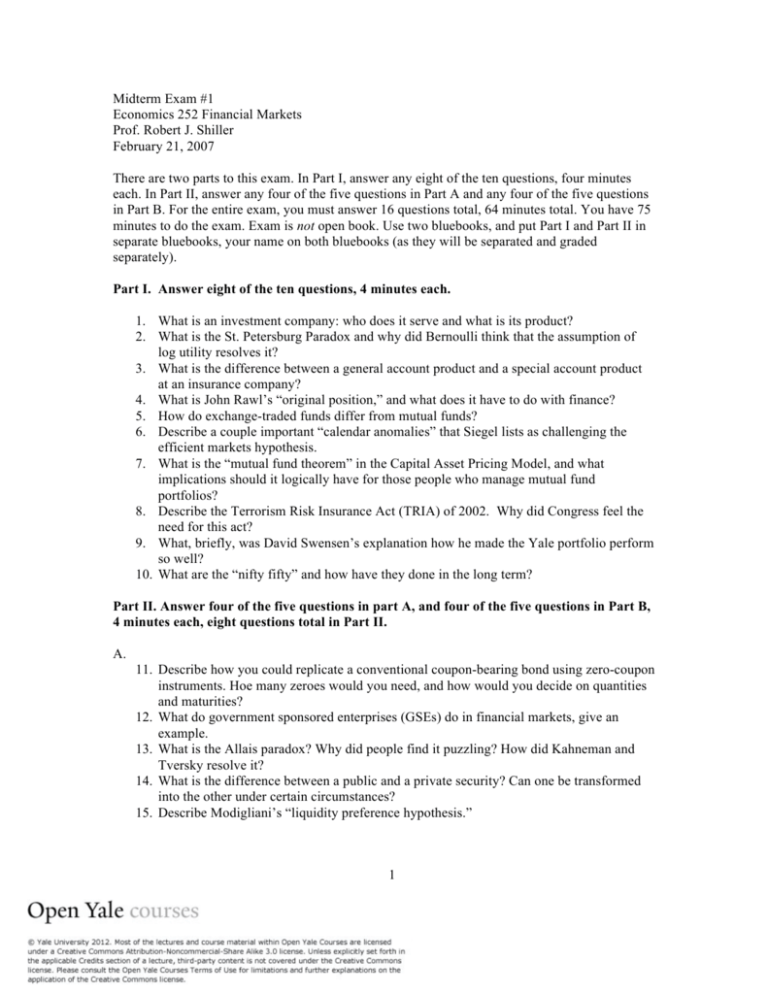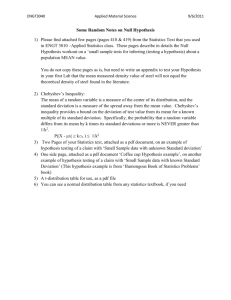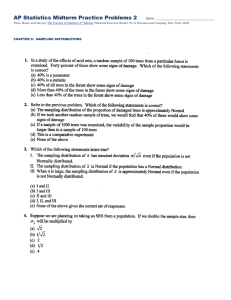Midterm Exam #1 Economics 252 Financial Markets Prof. Robert J
advertisement

Midterm Exam #1 Economics 252 Financial Markets Prof. Robert J. Shiller February 21, 2007 There are two parts to this exam. In Part I, answer any eight of the ten questions, four minutes each. In Part II, answer any four of the five questions in Part A and any four of the five questions in Part B. For the entire exam, you must answer 16 questions total, 64 minutes total. You have 75 minutes to do the exam. Exam is not open book. Use two bluebooks, and put Part I and Part II in separate bluebooks, your name on both bluebooks (as they will be separated and graded separately). Part I. Answer eight of the ten questions, 4 minutes each. 1. What is an investment company: who does it serve and what is its product? 2. What is the St. Petersburg Paradox and why did Bernoulli think that the assumption of log utility resolves it? 3. What is the difference between a general account product and a special account product at an insurance company? 4. What is John Rawl’s “original position,” and what does it have to do with finance? 5. How do exchange-traded funds differ from mutual funds? 6. Describe a couple important “calendar anomalies” that Siegel lists as challenging the efficient markets hypothesis. 7. What is the “mutual fund theorem” in the Capital Asset Pricing Model, and what implications should it logically have for those people who manage mutual fund portfolios? 8. Describe the Terrorism Risk Insurance Act (TRIA) of 2002. Why did Congress feel the need for this act? 9. What, briefly, was David Swensen’s explanation how he made the Yale portfolio perform so well? 10. What are the “nifty fifty” and how have they done in the long term? Part II. Answer four of the five questions in part A, and four of the five questions in Part B, 4 minutes each, eight questions total in Part II. A. 11. Describe how you could replicate a conventional coupon-bearing bond using zero-coupon instruments. Hoe many zeroes would you need, and how would you decide on quantities and maturities? 12. What do government sponsored enterprises (GSEs) do in financial markets, give an example. 13. What is the Allais paradox? Why did people find it puzzling? How did Kahneman and Tversky resolve it? 14. What is the difference between a public and a private security? Can one be transformed into the other under certain circumstances? 15. Describe Modigliani’s “liquidity preference hypothesis.” 1 B. Problem questions 16. Corporate stock A has expected return of 10% and a standard deviation of 20%. Corporate stock B has an expected return of 20% and a standard deviation of 40%. The two stocks are uncorrelated with each other. What is the lowest possible standard deviation I could obtain for the return of the portfolio, and what would be the proportion to put in Stock A and Stock B to achieve this minimum? 17. A dealer is quoting bid of 5.5% and ask of 5.4% on 180-day Treasury bills, and a bid of 5.7% and ask of 5.6% for 360-day Treasury bills. A client tells you she is willing to sign a contract now to invest $10,000,000 for six months in your firm at 6%, but she wants to wait six months to deliver the money, so you would get her $10,000,000 in six months and pay her back $10,300,000 in 360 days. Is there a way here for you to lock in a sure profit here today, without spending any of your firm’s capital? If so, explain how to do it, showing your calculations (involving a forward rate). If it is not possible, explain why not. 18. A small, poor, developing country is already seeing technical progress raise the output of its agricultural land by 1% a year, but this rate of increase hardly keeps up with population growth of 1.5% a year. The country contains a million hectares of agricultural land. Next year it is forecast that the profit from a hectare of land will be US$100, the year after that it is expected to grow to $101, and so on forever, under current assumptions. A research firm says that, for a one-time-only investment of US10 million today, it can create and implement new technology specific to that country that will result in the rate of growth of the output of land to increase to 2% a year forever. Next year, the profit from a hectare of land would be US$100 as before, but the year after that it would be US$102, and would continue to grow at 2% a year after that. Suppose the long term interest rate is 6%. What is the present value of benefit from this project? Should the World Bank finance this project for this country? Explain and show your calculations. 19. If a stock price is a random walk, how much larger is the annual standard deviation of price change (the standard deviation of the change in price at two points of time a year apart), when compared with the monthly standard deviation of price change (the standard deviation of the change in price at two points of time a month apart)? Explain. 20. Give an example of a forecasting variable that you could include in a regression explaining stock market changes to test each of the following: a. the weak form efficient markets hypothesis, b. the semi-strong form efficient markets hypothesis, c. the strongform efficient markets hypothesis. 2







